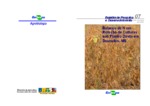Use este identificador para citar ou linkar para este item:
http://www.infoteca.cnptia.embrapa.br/infoteca/handle/doc/626863| Título: | Balanço de N em rotação de culturas sob plantio direto em Dourados, MS. |
| Autoria: | ALVES, B. J. R.  ZOTARELLI, L.   ARAÚJO, E. S.   FERNANDES, F. M.   HECKLER, J. C.   MEDEIROS, A. F. A.   BODDEY, R. M.   URQUIAGA, S.   |
| Ano de publicação: | 2005 |
| Referência: | Seropédica: Embrapa Agrobiologia, 2005. |
| Páginas: | 21 p. |
| Conteúdo: | Matéria seca e N total. Quantificação da FBN eficiência do uso de N fertilizante. Balanço de N para as culturas. Resultados e discussão. Quantificação da FBN para a cultura da soja. Eficiência da fertilização. Balança de N para as culturas. O objetivo do presente estudo foi avaliar o impacto da fixação biológica de nitrogênio (FBN) na cultura da soja e a eficiência do uso de fertilizantes nitrogenados pelas culturas do milho e algodão sobre o balanço de N dos solo. O experimento foi realizando em Latossolo Vermelho distroférrico, na área experimental da Embrapa agropecuária oeste, em dourados, MS. Todas as culturas foram conduzidas em uma área onde se iniciou o plantio direto. No primeiro ano , as culturas do milho e algodão receberam 115kg N há-1 , parcelados em 25kg N há-1 na forma de uréia no plantio, e mais duas doses de cobertura de 45 kg N há-1, aos 26 e 48 dias após emergência das plantas (dae) . no segundo ano a cultura do milho recebeu 70 kg há-1 em cobertura, aos 29 dae. Por duas safras consecutivas avaliaram-se a contribuição da FBN para a cultura da soja, através da abundância natural de 15N, e a eficiência de uso do fertilizante nitrogenado (EUFN) pela cultura do milho, e em safra com a do algodão, utilizando-se fertilizante enriquecido com 15N. As avaliações incluíram também a produtividade e acumulação de N pela parte aérea das culturas. O balanço de N foi calculado como a diferença entre o total de N que entrou no sistema (fertilizantes e FBN ) menos a saída de N (produção colhidos e perdas). A contribuição da FBN para a cultura da soja, nos dois anos sob avaliação foi superior a 80% do N acumulado pelas plantas, o que garantiu elevados níveis de produtividade sem diminuir as reservas de N do solo. Nas condições do estudo, a EUFN para as culturas do milho e algodão foi próximo dos 20% no plantio, e aos 26 e 48 dae variou entre 50 e 60% para a cultura do milho, e em torno de 70% para a do algodão, apesar das doses de N mais elevadas na cobertura. No entanto, para os níveis de produtividade obtidos, as doses aplicadas não foram suficientes para compensar a saída de N, o que sugere a necessidade de que o manejo do sistema seja alterado para diminuir e/ou balançar as perdas de N. The present study aimed to evaluate the impact of biological nitrogen fixation to soybean (BNF) and the nitrogen use efficiency of nitrogenous fertilizers to maize and cotton on the soil N balance. The experiment was carried out on a Oxisol (distrophic Haplorthox) at the experimental area of Embrapa western Agriculture located in dourados, MS state, Brazil. All cros were planted in an area under zerotillage for the first year, maize and cotton crops were fertilized with 115 kg N há-1 split in 25 kg N há-1 at seeding as urea, and dressing rates of 45 kg N há-1 at 26 and 48 days after emergence (dae). In the second year, the maize crop received only 70 kg N há-1 as dressing fertilization at 29 dae. For two consecutive harvests the BNF contribution was evaluated to soybean by the use of natural 15N abundance technique, and the nitrogen fertilizer use efficiency (NFUE) by the maize crop, and in one harvest for cotton, using 15N enriched fertilier. The evaluations also included yield and N accumulation by the shoot of the crops. The N balance was calculated by the difference o N inputs (fertilizer and BNF) and outputs (harves products and losses). Fertilizer-N losses estimates took into consideration that 25% of applied N was held in the soil, based on literature data and the avaluations performed in the second year with the maize crop. For two years, the BNF contribution to soybean was over 80% which guaranteed high yields wiithout reduction of soil N reserves. Under the study condition, the NFUE for maize and cotton was close to 20% for the seeding rate. For the dressing applications at 26 and 48dae NFUE varied between 50 and 60% for maize and around 70% for cotton, despite of the highest N at dressing fertilization. However, at the present yields the N rates were not enough for compensating outputs unless the system management being altered to reduce N losses. |
| Thesagro: | Algodão Milho Plantio Direto Rotação de Cultura Soja |
| NAL Thesaurus: | cotton nitrogen balance |
| Palavras-chave: | Balanço de nitrogênio Fixação biológica de nitrogênio FBN Zero tillage Direct sowing Rotational cropping Biological nitrogen fixation BNF Soybean Maize |
| Série: | (Embrapa Agrobiologia. Boletim de Pesquisa e Desenvolvimento, 7). |
| ISSN: | 1676-6709 |
| Tipo do Material: | Folhetos |
| Acesso: | openAccess |
| Aparece nas coleções: | Boletim de Pesquisa e Desenvolvimento (CNPAB)  |
Arquivos associados a este item:
| Arquivo | Descrição | Tamanho | Formato | |
|---|---|---|---|---|
| bot007.pdf | 350.8 kB | Adobe PDF |  Visualizar/Abrir |









